Is your lettuce bolting? Are you looking for a heat-tolerant lettuce that grows well all summer long? Oak leaf lettuce to the rescue!
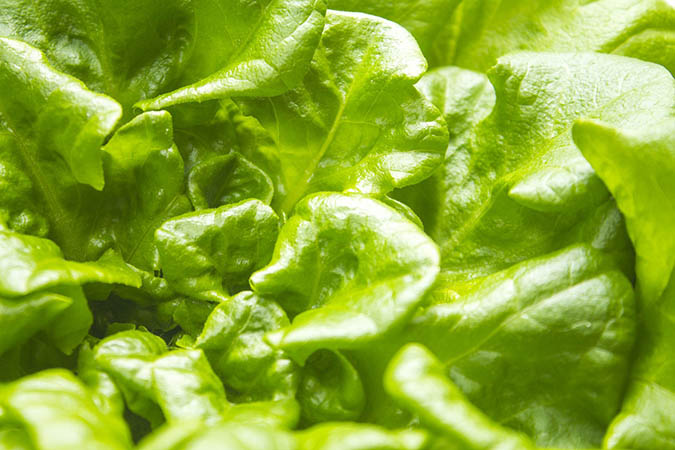
Image by Hannes Kurth from Pixabay
Heat? Drought? Delicious Oak Leaf Lettuce Thrives Anyway!
Nothing says summer like a crisp, fresh-from-the-garden salad with lettuce, tomatoes, and cucumbers. Unfortunately, depending on your climate, your lettuce might be bolting before your tomatoes ripen and your cucumbers explode.
This article on growing oak leaf lettuce is part of our Green of the Month series. To read the rest of the articles in the series, click here.
That’s because lettuce is predominantly a cool-weather crop. It’s not so much a summer food as it is a spring and fall food. Yet, the mystique of the summer salad persists….
Thankfully, there’s the mighty oak leaf lettuce, which comes to the rescue to save your summer salad (from being bitter and blah!).
The Goods on Oak Leaf Lettuce
Back when I was a beginning gardener, I stumbled on some oak leaf lettuce seeds at a gardening event. I went home and planted those things in July in 90ºF weather. I watered them for a couple of weeks. Then, honestly, it was so hot that I skimped on my gardening care for a few weeks and opted to stay indoors.
When the heat streak broke and I assessed the damage to my garden, I found my kale and beets had flower heads. My arugula was a stringy, chewy, inedible mess. My sunflowers were 7 feet tall. And growing happily in a nearby bed, in the partial shade of those sunflower stalks, were some equally giant oak leaf lettuce heads.
You May Also Enjoy:
“Growing Kohlrabi: A Sweet and Tangy Cool-Season Crop”
“Growing Mâche: The Little Lettuce That Lasts All Winter”
“Mustard Greens: What You Need to Know Before You Grow (With Recipe)”
In about 45 days, in ridiculous heat, with just a bit of afternoon shade and minimal watering, I’d grown incredible lettuce. Since I was a novice gardener at the time, I just thought that’s how lettuce grew.
Little did I know, I had just lucked into one of the few lettuces that had a chance of withstanding those harsh conditions. Now that I grow lots of other kinds of lettuce almost year-round, I appreciate the benefits of oak leaf lettuce even more.
1. Tolerant of Heat, Drought, and Cold
As my early gardening experience with oak leaf lettuce proved—and all my experience since has confirmed—this stuff is incredibly heat tolerant and drought resistant. Oh, and it survives our first few frosts here in North Carolina, too!
Now, it is still lettuce, so it does appreciates some extra TLC to keep it happy. Planting it on the north side of taller plants and mulching it to keep roots moist go a long way toward good production.
Still, the fact that you can grow it in the middle of summer and not have it taste like a mouthful of dirt is pretty incredible.
2. Delicious
That brings me to the next thing to love about oak leaf lettuce. It’s delicious. Fresh, cut, rinsed in cool water, and chilled in the fridge for a little bit, this stuff eats like romaine but with all the flavor of mesclun.
You May Also Enjoy:
“Growing Arugula: The Rocket in Your Salad Bowl and Garden (With Recipe)”
“Chard en Garde Manger: The Delicious 3-Season Green for Food Security”
3. Beautiful
As if I haven’t given you enough reasons to grow this stuff already, oak leaf lettuce leaves also happen to be some of the most beautiful you can grow. They work great as a cut baby green or as chopped large-leaf greens. They also make heads so stunning you can use them as table decorations.
4. Hydrating, Filling, and Nutritious
One of the reasons why so many of us love salads in the middle of summer heat is because those leafy greens are almost entirely water. They have the effect of cooling us off and quenching our thirst while those fiber-rich leaves also satisfy our hunger.
At just 10 calories a cup, with upwards of 20% of your daily requirements of vitamin C and iron, this stuff makes a great, guilt-free summer pleasure.
How to Serve Oak Leaf Lettuce
This lettuce has so much natural flavor and is so perfectly beautiful that it’s a shame to bury it in dressing. So, I often don’t! Instead, I plate up my oak leaf lettuce.
Cut your oak leaf lettuce head at the stalk, leaving behind a couple inches of stalk so it can regrow. Rinse the head in a bowl of cool water. Hang it upside down to dry for a few minutes. If you have time, set it on a towel in the fridge for 15-20 minutes to chill it and let it dry more.
You May Also Enjoy:
“Purslane: The Omega-3 You Can Grow for Free! (With Recipe)”
“Growing Spinach: Pack a Punch in a Little Bunch”
“Sweet Potato Vines: How to Grow This Antioxidant Powerhouse”
Lay the head out on a plate. Fan the leaves out a bit to make room for a ramekin of dressing. Top with some kind of decorative herb. I like shiso (red perilla) or purple basil as my garnish because the color contrast is stunning.
Serve this with a knife to cut portions of the leaves as a family-style plate. Alternately, if you harvest smaller heads, you can serve one to each person at a dinner party or brunch.
You can use any dressing for this presentation. One of my favorite dressing pairings with oak leaf is Honey Mustard With Thyme.
Honey Mustard With Thyme Dressing [RECIPE]
To make my favorite honey mustard dressing, it takes just 6 ingredients.
- 1 part raw honey
- 1 part Dijon-style mustard
- 1 part olive oil
- Salt
- Pepper
- Thyme leaves
Mix the first 3 ingredients together. Then, add the salt and pepper to taste. At the end, sprinkle your dressing with thyme leaves.
Or, if you want to get really fancy, you can infuse your honey with thyme 2 weeks in advance to really extract all that flavor. Just fill half a jar with thyme, cover with honey, and allow the mix to sit in a warm location for 2 weeks. Then, strain the honey from the leaves.
Serve this dressing as part of your plated oak leaf. Mix it in bowls of baby greens or chopped greens. Or, drizzle it over large loose leaves and sprinkle with bacon and your favorite nuts to make it a meal.
A Few Cautions About Oak Leaf
Now, there are also a few things to be aware of when it comes to oak leaf lettuce.
1. It’s in the Lettuce Family (a.k.a. Daisy or Asteraceae Family)
Lettuce likes really fertile soil with a healthy dose of nitrogen. If you are using crop rotation for pest control, pathogen prevention, and nutrient management, you will want to rotate your lettuce beds at least annually. For best results, you also want to put this plant at the start of your nitrogen cycle for best results.
Read More: “Supercharge Your Garden! 4 Steps to Vibrant Soil Using Compost and Crop Rotation”
2. Slugs, Ugh!
Pretty much all lettuce is susceptible to slug and cutworm damage, particularly in wet conditions. Mature oak leaf heads are pretty full and tight, so they don’t seem to end up with as many slugs between the leaves as some of my other lettuces. However, I do often see slug and cutworm damage around the collar of the plant and in the outer leaves nearest to the ground after heavy rains.
Mulch and proper plant spacing minimize the risk of these pest invasions.
3. Lettuce Times Out
Unlike some of our other Greens of the Month like chard and kale, lettuce has a shorter life cycle than those longer-standing greens. I get the best yields if I grow one large head. Then, I scatter some new seeds underneath the original plant to start more.
I continue to harvest cut greens from the original plant until the new seedlings start to take off. Then I cut the old plant to the ground to make way for the new.
For lettuces, even the mighty oak leaf kind, I always plant often to have a continuous supply.
Growing Oak Leaf Lettuce
Oak leaf is about the easiest lettuce to grow. But, it’s still lettuce, which means it needs ideal garden soil and regular weeding for good production.
Soil Preparation
Don’t try to grow lettuce unless you have good garden soil. You’ll spend all your time weeding and watering your lettuce and still have less-than-wonderful production.
Many people with less-than-ideal garden soil will grow lettuce in containers or raised beds using garden soil mixes.
If you have good, but not quite ideal, garden soil, you can add a few inches of well-aged compost to top-dress your beds. As lettuce starts growing, you may also want to mulch beneath the base of the plants to keep roots moist.
Seed Starting
Lettuce is easiest to start direct in the garden bed or container. Scatter seeds on top of your bed and then water them in using a gentle-flow watering can or hose head.
If you have a lot of birds, you can put a light dusting of compost on top of the seeds as protection. However, the deeper you plant, the longer it will take for your seedlings to emerge.
You May Also Enjoy:
“How to Start Seeds Like a Professional Grower”
I always over plant and then thin the extra seedlings by cutting them off at ground level to use as baby greens. Lettuce really seems to like a lot of company when it first starts growing.
Young Plant Care
Make sure to thin extra seedlings as plants grow. Crowded lettuce is prone to pest problems and root rot.
If you are growing your oak leaf primarily for baby greens, plants need about 2-3 inches of space to produce 4-6 inch leaves. If you are going for large heads, give plants about 6-8 inches of space or a little more in wet, humid areas.
You May Also Enjoy:
“Special Challenges to Managing NPK in the Organic Garden”
Once the plants are a few inches tall, leaf growth should happen quickly. Depending on the variety planted, your oak leaf lettuce should mature in 45-60 days.
If your lettuce seems to be growing too slowly to head up on time, begin biweekly applications of compost tea or other direct-apply, fast-acting fertilizers to improve growth rates.
Stay on top of weeds so they don’t crowd out your lettuce and host pests that might eat your lettuce before you do.
Mature Plant Care and Harvesting
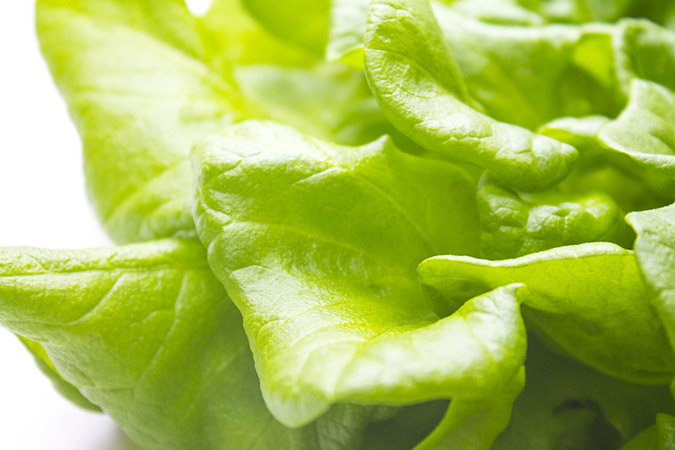
Image by Hannes Kurth from Pixabay
Young lettuce has a milder taste and a softer texture than mature lettuce. Most people don’t enjoy the bitter taste that evolves as lettuce ages. Although oak leaf lettuce resists bolting and remains tasty longer than many other lettuce varieties, it’s still best eaten young.
For peak flavor, harvest when heads are at 6-8 inches across. Allow new growth on old stocks only as long as the plant is fast-producing and sweet-tasting.
Start new seeds under old plants to help climatize the soil for good germination. Then remove older plants as seedlings begin to take off.
Watch for slugs and cutworms around the plant’s base, particularly as mature plants begin to grow closer to each other. Harvest every other lettuce head to create air space as plants near mature size.
Varieties of Oak Leaf Lettuce
Oak leaf lettuce is an heirloom. Seeds have been saved and handed down for hundreds of years. As a result, there are a lot of different strains of oak leaf lettuce that have evolved in different locations.
For example, Seed Savers Exchange has a variety that is reportedly known as Baltimore of Philadelphia Oak Leaf from the 1880’s. Baker Creek Heirloom Seeds has a variety from 1771 introduced by the French company Vilmorin. Johnny’s Selected Seeds has a number of adapted oak leaf lettuce offerings in a range of red and green colors.
Most of the longtime heirloom oak leaf seeds make green heads. However, many seed companies have started to offer red oak leaf heads, as well.
When possible, obtain seeds from growers with gardening conditions similar to yours.
Unconventional Growing Tips for Adventure Gardeners

Image by Mircea Ploscar from Pixabay
In general, I don’t normally try to grow anything under sunflowers. I have heard they make good bean trellises. However, my experience has been that the sunflowers I grow (Titan or Mammoth) don’t make good companions for any other plants.
You May Also Enjoy:
“Spice Things Up With These Healthy Salad Greens”
“Companion Planting Favorites (Your Answers to the Question of the Month!)”
Two years ago, though, I tried growing oak leaf under my sunflowers to take advantage of that mid-day shade. To my surprise, oak leaf lettuce even grew well right under my sunflowers. I did have to apply some compost tea to keep both plants well-nourished. But I had big, beautiful oak leaf heads well into August with minimal effort on my part.
If you want to give this a try, start the sunflowers first. Wait until they are about two feet tall, then scatter your oak leaf lettuce seeds and cover with a bit of compost. If your soil is nutrient deficient, the sunflowers will win. Worst case, you waste a few lettuce seeds. Best case, you get lettuce and sunflowers from the same bed.
Tell Us What You Think!
Have you tried oak leaf lettuce? Did they grow just as well for you? What’s your favorite dressing for those delectable, heat-loving heads? Use the comments section below to share your experience!
_____________________
This is an updated version of an article that was originally published on July 28, 2019. The author may not currently be available to respond to comments, however we encourage our Community members to chime in to share their experiences and answer questions!
The Grow Network is a participant in the Amazon Services LLC Associates Program, an affiliate program designed to provide a means for our team to earn fees for recommending our favorite products! We may earn a small commission, at no additional cost to you, should you purchase an item after clicking one of our links. Thanks for supporting TGN!

Tasha Greer is a regular contributor to The Grow Network and has cowritten several e-books with Marjory Wildcraft. The author of “Grow Your Own Spices” (December 2020), she also blogs for MorningChores.com and Mother Earth News. For more tips on homesteading and herb and spice gardening, follow Tasha at Simplestead.com.
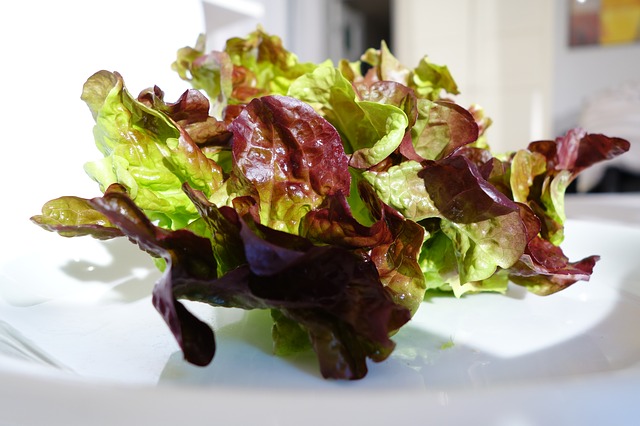



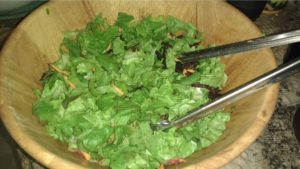
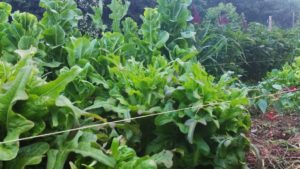







COMMENTS(1)
Does anyone know if this will grow in Southwest Florida, which is either 10a or 10b (depending on the chart)? Frost is rarely an issue here.